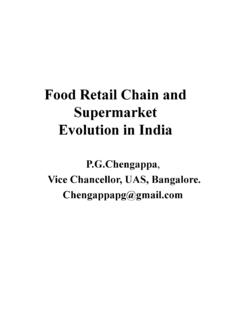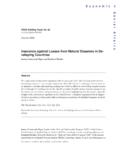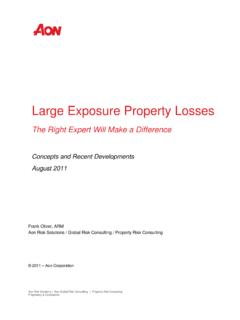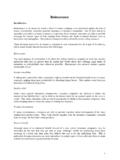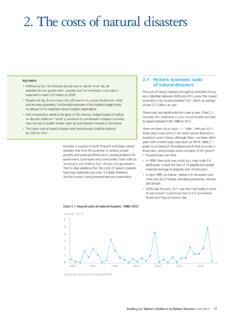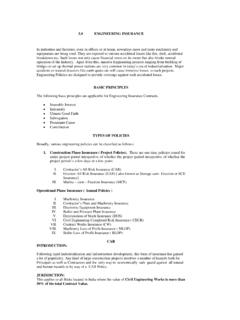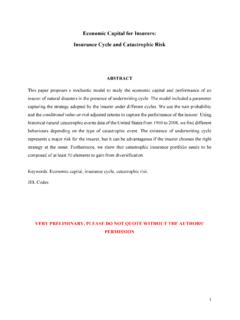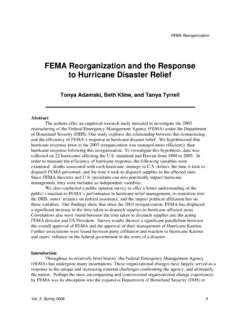Transcription of Agricultural Insurance in India Problems and Prospects
1 I NCAP Working Paper No. 8 Agricultural Insurance in India Problems and Prospects Raju and Ramesh Chand National Centre for Agricultural Economics and Policy Research (Indian Council of Agricultural Research) Post Box No. 11305, Library Avenue, Pusa, New Delhi 110012, India Phones: (Tele): 25848731, 25847628 Fax : 2584 2684 E-mail: , March 2008 ii Agricultural Insurance in India Problems and Prospects S. S. Raju Senior Scientist Ramesh Chand National Professor March 2008 National Centre for Agricultural Economics and Policy Research (Indian Council of Agricultural Research) New Delhi iii Contents List of Tables and Figure iv Acknowledgements vi Chapter 1 Introduction 1 OBJECTIVES OF THE STUDY 2 Chapter 2 Review of Agricultural Insurance Literature 3 Chapter 3 Method and Data 7 Chapter 4 Risk in Agriculture Production 9 ALL India PICTURE 9 STATE LEVEL PICTURE 11 Rice 11 Wheat 12 Groundnut 13 Rapeseed and Mustard 14 Cotton 15 Sugarcane 16 RISK IN ANDHRA PRADESH AGRICULTURE AT 17 DISAGGREGATE LEVEL Risk at district level for the state of Andhra Pradesh 19 Factors affecting risk 21 Chapter 5 Progress and Performance of Agriculture Insurance 23 CROP Insurance APPROACHES 23 Agricultural Insurance SCHEMES 24 First Individual Approach Scheme 1972-1978 24 Pilot Crop Insurance Scheme (PCIS)
2 1979-1984 24 Comprehensive Crop Insurance Scheme (CCIS) 1985-99 26 Experimental Crop Insurance Scheme (ECIS) 1997-98 27 National Agricultural Insurance Scheme (NAIS) 28 1999- DATE OTHER Agricultural Insurance SCHEMES 34 Farm Income Insurance 34 Livestock Insurance 34 Weather Based Crop Insurance / Rainfall Insurance 35 COMPARATIVE PICTURE OF VARIOUS Agricultural 37 Insurance SCHEMES iv Chapter 6 Farmers Perceptions about Agricultural Insurance : 39 Field Level Results from Andhra Pradesh SOCIO-ECONOMIC CHARACTERISTICS OF SAMPLE 39 FARMERS RESPONSE OF LOANEE FARMERS 40 RESPONSE OF NON-BORROWER AND NOT 42 INSURED FARMERS Chapter 7 Issues Related to Agricultural Insurance 45 ISSUES RELATED TO NAIS 45 Reduction of Insurance unit to Village Panchayat level 45 Threshold / guaranteed yield 46 Levels of indemnity 46 Extending risk coverage to prevented sowing / planting.
3 46 in adverse seasonal conditions Coverage of post-harvest losses 46 On-account settlement of claims 47 Service to non-loanee farmers 47 Premium sharing by financial institutions 47 GENERAL ISSUES 48 Role of Government 48 Perils to be covered 49 Involvement of Public or Private Sector 50 INDIVIDUAL/ AREA APPROACH AND COVERAGE 50 ASSURED VALUE, LOSS ASSESSMENT AND PREMIUM 50 Chapter 8 Global Picture of Agricultural Insurance 51 LESSONS FROM OTHER COUNTRIES 51 WORLD TRADE ORGANIZATION REGULATIONS 54 Chapter 9 Conclusions and Policy Suggestions 55 CONCLUSIONS 55 POLICY SUGGESTIONS 56 Prospects OF Agricultural Insurance 58 References 59 Glossary of Agricultural Insurance Terms 61 Annexure -I Schedule for collection of primary data on borrowed insured farmer 66 perception on Agricultural Insurance Annexure II Schedule for collection of primary data on Non- borrower not 72 insured farmer perception on Agricultural Insurance Annexure III Schedule for agencies / personnel dealing with Agricultural Insurance 77 v List of Tables and Figure
4 Table : Crop wise instability in area, yield and output, all India (%) 10 Table : Risk in rice production and area under irrigation (%) 12 Table : State wise risk in wheat production and area under irrigation (%) 13 Table : State wise risk in groundnut production and area under irrigation (%) 14 Table : State wise risk in rapeseed and mustard production and area under 15 irrigation (%) Table : State wise risk in cotton production and area under irrigation (%) 16 Table : State wise risk in sugarcane production and area under irrigation (%) 17 Table : Risk in area, production, yield, farm harvest prices and gross revenue 19 from important crops in Andhra Pradesh, 1980-81 to 2003-04 Table : Range of risk in area, production, yield, farm harvest prices and 20 gross revenue at disaggregate level (%) Table : Distribution of district based on significant change in level of risk 20 Table : Factors related to risk in Andhra Pradesh 21 Table : Performance of Pilot Crop Insurance Scheme during 1979-80 25 to 1984-85 Table : State-wise CCIS performance during 1985 1999 27 Table : Crop-wise CCIS performance during 1985 1999 27 Table : Season wise performance of the National Agricultural 29 Insurance Scheme Table : Season-wise share of insured farmers in total holdings and area 30 (%) Table : Year-wise performance of National Agricultural Insurance Scheme 31 Table : State-wise distribution of Insurance cases, area and claim to premium 32 ratio under NAIS Table : Average area, sum insured, premium paid and indemnities claimed 33 under NAIS by states Table.
5 Progress of livestock Insurance 34 Table : Comparison of yield and weather Insurance 37 Table : Various schemes related to crop Insurance in India and their features 38 Table : Socio-economic characteristics of sample households 39 Table : Loan received and risk bearing ability of borrower insured farmers 40 in Andhra Pradesh Table : Motivation and experience of borrowed farmers with Insurance 40 Table : Borrowers perception on premium rate 41 Table : Suggestions made by loanee farmers for improving Insurance 42 Table : Non-borrower not insured farmers' perception on Agricultural 43 Insurance in Andhra Pradesh Table : Non-borrower not insured farmers' perception on strategy to face loss 43 In Andhra Pradesh Table : Non-borrower not insured farmers' perception on preference for 44 Insurance agency in Andhra Pradesh Table : Crop Insurance support mechanism of major countries 49 vi Table : Financial performance of crop Insurance programmes in 54 seven countries Figure Fig : Sample Selection 8 vii Acknowledgements We would like to place on record our sincere thanks to the National Centre for Agricultural Economics and Policy Research (ICAR) for providing us an opportunity to take up this study.
6 We express our gratitude to Dr. , Director, NCAP for extending centre s support for this study. We are grateful to Mr. , Manager, Agricultural Insurance Company of India Ltd (AICL), New Delhi, for his constant support in primary data collection and helpful suggestions in the course of the study. We also thank the farmers and officials of the AIC, Agricultural department, bankers, academicians and other representatives in New Delhi as well as Andhra Pradesh for sharing valuable data about Agricultural Insurance . Finally, we would like to place on record the help rendered by Ms. Umeeta Ahuja and Mr. Deepak Tanwar in preparing the computer script. Ramesh Chand 1 Chapter 1 Introduction Agriculture production and farm incomes in India are frequently affected by natural disasters such as droughts, floods, cyclones, storms, landslides and earthquakes.
7 Susceptibility of agriculture to these disasters is compounded by the outbreak of epidemics and man-made disasters such as fire, sale of spurious seeds, fertilizers and pesticides, price crashes etc. All these events severely affect farmers through loss in production and farm income, and they are beyond the control of the farmers. With the growing commercialization of agriculture, the magnitude of loss due to unfavorable eventualities is increasing. The question is how to protect farmers by minimizing such losses. For a section of farming community, the minimum support prices for certain crops provide a measure of income stability. But most of the crops and in most of the states MSP is not implemented. In recent times, mechanisms like contract farming and future s trading have been established which are expected to provide some Insurance against price fluctuations directly or indirectly.
8 But, Agricultural Insurance is considered an important mechanism to effectively address the risk to output and income resulting from various natural and manmade events. Agricultural Insurance is a means of protecting the agriculturist against financial losses due to uncertainties that may arise Agricultural losses arising from named or all unforeseen perils beyond their control (AIC, 2008). Unfortunately, Agricultural Insurance in the country has not made much headway even though the need to protect Indian farmers from agriculture variability has been a continuing concern of agriculture policy. According to the National Agriculture Policy 2000, Despite technological and economic advancements, the condition of farmers continues to be unstable due to natural calamities and price fluctuations.
9 In some extreme cases, these unfavorable events become one of the factors leading to farmers suicides which are now assuming serious proportions (Raju and Chand, 2007). Agricultural Insurance is one method by which farmers can stabilize farm income and investment and guard against disastrous effect of losses due to natural hazards or low market prices. Crop Insurance not only stabilizes the farm income but also helps the farmers to initiate production activity after a bad Agricultural year. It cushions the shock of crop losses by providing farmers with a minimum amount of protection. It spreads the crop losses over space and time and helps farmers make more investments in agriculture. It forms an important component of safety-net programmes as is being experienced in many developed countries like USA and Canada as well as in the European Union.
10 However, one need to keep in mind that crop Insurance should be part of overall risk management strategy. Insurance comes towards the end of risk management process. Insurance is redistribution of cost of losses of few among many, and cannot prevent economic loss. There are two major categories of Agricultural Insurance : single and multi-peril coverage. Single peril coverage offers protection from single hazard while multiple 2 peril provides protection from several hazards. In India , multi-peril crop Insurance programme is being implemented, considering the overwhelming impact of nature on Agricultural output and its disastrous consequences on the society, in general, and farmers, in particular. This present study looks at the genesis of Agricultural Insurance in India , examines various Agricultural Insurance schemes launched in the country from time to time and the coverage provided by them.
